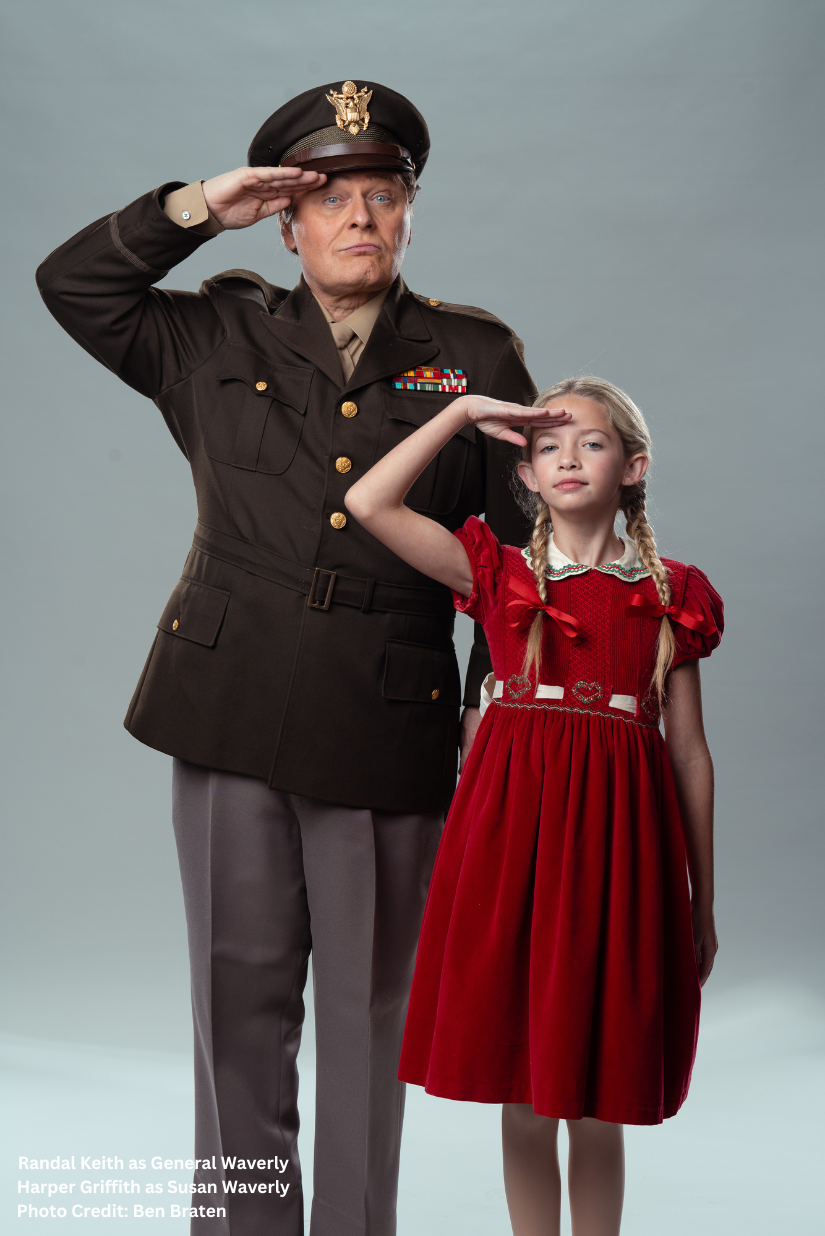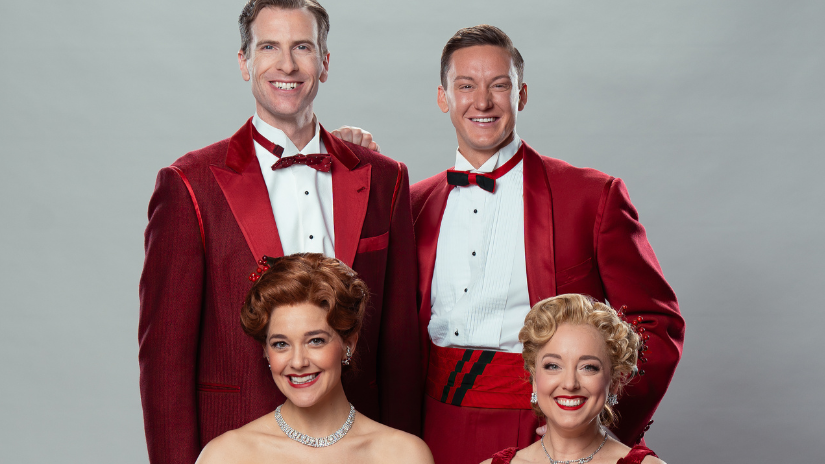IVINS — Nestled in the red rocks of southern Utah, the Hafen Theatre at Tuacahn Center for the Arts twinkled with festive lighting on November 27 in a glowing anticipation of Irving Berlin’s White Christmas. The musical is a stage adaptation of the 1954 film of the same name and tells the story of two military vets a decade after the second world war has ended who find themselves performing at the rural inn owned by their former military general. In true melodramatic fashion, there is impending financial ruin that will take the General’s whole savings at Christmas time, and only the story’s hero — Bob Wallace — can save it all. In doing so, he wins the heart of the glamorous lady, Betty Haines, that Bob did not know he needed.

I always appreciate a clean and simple set with strong lighting design. My hopes were satisfied with Paul Black‘s lighting design, which allowed the focused attention on the performers via creative and clever choices. In one sequence, Bob is singing about how swell life seems to be going for him, and he and the ensemble do a dance routine called “Blue Skies,” which begins as a routine for the performers at the inn. The number starts in the barn where the actors practice, and then projections and lighting change the scene into a relaxing dance amongst the clouds. The sudden shift back to the barn at the end was a nice return to reality and was expertly executed technically.
The heartwarming story of White Christmas features many elements of the play-within-a-play trope and provide an excuse for some truly incredible dancing and crooning as characters rehearsed their performance. Especially impressive among these numbers were the tap routines in “Blue Skies” and “I Love a Piano.” “Blue Skies” featured some truly incredible formation work, as dancers would tap seamlessly on and off stage in a dreamlike sequence. Meanwhile, characters who were not dancing, such as stage manager Mike Nulty (played by Rendell Debose) and the farmhand Ezekiel Foster (played by Joel Newsome), added funny juxtaposition to the splendid dancing around them. “I Love a Piano” featured the dazzling spectacle of Judy Haines (played by Jessica Wockenfuss) and Phil Davis (played by Ben Lanham) tap dancing on top of a piano set piece that rotated on a platform. The piano looked a touch unsteady, but the dancing on top of it and around it was exhilarating to watch. I think Bing Crosby and Danny Kaye would have been pleased with how the Tuacahn production matched the energy and jubilation in these dance numbers.
The leading actors in White Christmas were spectacular in every way. The pacing and timing of the banter between Wockenfuss and Kerry Conte (the latter in the role of Betty Haines) was authentic and charming in their banter. These two on-stage sisters had particularly good chemistry during the song “Falling Out of Love Can Be Fun,” as they would listen intently and seemed to genuinely enjoy one another’s disdain for love and the men that accompanied it. The reprisal of “Sisters” from Lanham and Dan Fenaughty (as Phil Davis) was as technically good as the women’s original rendition, but an order of magnitude funnier as the men paraded through the number in their rolled up pants and attempts at tantalizing in Christmas socks. The romantic parings were similarly successful. Bob and Betty were painfully, but hilariously, uncomfortable in that way that only great actors and the truly awkward can be. Phil and Judy’s on-again/off-again romance does not make a ton of sense in David Ives and Paul Blake‘s script, but their chemistry was fun and provided a great foil to Bob and Betty.

I deeply appreciated Newsome’s acting as he played simpleton farmhand Ezekiel Foster. Despite the fleet footwork of every other member of the cast, Newsome’s Foster featured a floppy gait reminiscent of Bugs Bunny ambling along. Most of his lines were simply the word “yep” and after the first, each built with anticipation as he would mosey across the stage to the person speaking to him and pallidly deliver his one word line. It was a fantastic display of character acting that broke into a fun moment near the end when Foster was alone in front of the curtain doing a makeshift routine with a broom that brought the house down.
Director and choreographer Mara Newbery Greer is seriously committed allowing White Christmas to be festive and lighthearted. The show was largely an enjoyable romp through memorable showtunes and Christmas classics that even the audience sung along to. After the final bows, the cast invited the audience to join them in one last chorus of “White Christmas,” and it provided warm feelings on a brisk November night. I do feel that there was a missed opportunity in the show to connect with the audience one level deeper. In past shows I have attended at Tuacahn, there have been invitations for veterans and members of the armed forces to stand for acknowledgement. This production began with men in uniform on stage singing before an large and well maintained American flag. At the end when the general speaks to supposed men in the audience, I hoped that it would be a chance to offer recognition to those in the service, but the moment passed and good actors stayed in character.
Overall, Tuacahn’s production of White Christmas was a fun night out. The production mixes the heart of community theatre with the grandeur of a Tuacahn production. Patrons were friendly and sociable with one another, the mood was light, and there’s some wonderful communitas that happens when audience members sing together from the heart. Indeed, it is a show fit for the USO. White Christmas is a production I will warmly remember with every Christmas card I write.
[box]The Tuacahn Center for the Arts production of Irving Berlin’s White Christmas plays nightly (except Sundays) at 7:45 PM through December 22, with matinees at 2 PM on Saturdays and on December 15, 18, 21, and 22, at the Hafen Theatre (1100 Tuacahn Drive, Ivins). Tickets are $32-92. For more information, visit tuacahn.org.[/box]

